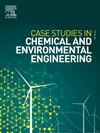Advanced approaches to microplastic removal in landfill leachate: Advanced oxidation processes (AOPs), biodegradation, and membrane filtration
Q1 Environmental Science
Case Studies in Chemical and Environmental Engineering
Pub Date : 2024-12-12
DOI:10.1016/j.cscee.2024.101056
引用次数: 0
Abstract
Landfill leachate treatment (LLT) processes contribute to the release of microplastics (MPs) into surface waters during solid waste disposal. These MPs can be transported and accumulate in various environmental compartments. This review highlights studies on the treatment of microplastics in landfill leachates and identifies current mitigation techniques. Feasible methods for reducing microplastics at laboratory and pilot scales include sequencing batch reactors (SBRs), artificial soil filtration (ASF), sand bed filtration (SBF), membrane bioreactors (MBRs) with ultrafiltration (UF), nanofiltration (NF), aerobic bioreactors with UF, membrane bioreactors with activated sludge (AS), and reverse osmosis (RO). The effectiveness of these methods depends significantly on the techniques used for MP extraction and polymer identification. Despite these advancements, the removal of microplastics through leachate treatment plants remains largely underexplored. It is critical to develop novel, efficient, and sustainable strategies for mitigating microplastics from landfill sites. Further research is urgently needed to enhance our understanding of the quantities, shapes, and types of polymers released into the environment through landfill leachate.

垃圾渗滤液中微塑料去除的先进方法:高级氧化工艺(AOPs)、生物降解和膜过滤
垃圾填埋场渗滤液处理(LLT)过程有助于在固体废物处理过程中将微塑料(MPs)释放到地表水中。这些MPs可以在不同的环境隔间中运输和积累。本综述重点介绍了垃圾填埋场渗滤液中微塑料的处理研究,并确定了当前的缓解技术。在实验室和中试规模上,减少微塑料的可行方法包括序批式反应器(sbr)、人工土壤过滤(ASF)、砂床过滤(SBF)、膜生物反应器(mbr)与超滤(UF)、纳滤(NF)、好氧生物反应器(UF)、膜生物反应器与活性污泥(AS)和反渗透(RO)。这些方法的有效性在很大程度上取决于用于MP提取和聚合物鉴定的技术。尽管取得了这些进步,但通过渗滤液处理厂去除微塑料的方法在很大程度上仍未得到充分探索。开发新颖、高效和可持续的策略来减少垃圾填埋场的微塑料是至关重要的。迫切需要进一步的研究来提高我们对通过垃圾填埋场渗滤液释放到环境中的聚合物的数量、形状和类型的理解。
本文章由计算机程序翻译,如有差异,请以英文原文为准。
求助全文
约1分钟内获得全文
求助全文
来源期刊

Case Studies in Chemical and Environmental Engineering
Engineering-Engineering (miscellaneous)
CiteScore
9.20
自引率
0.00%
发文量
103
审稿时长
40 days
 求助内容:
求助内容: 应助结果提醒方式:
应助结果提醒方式:


